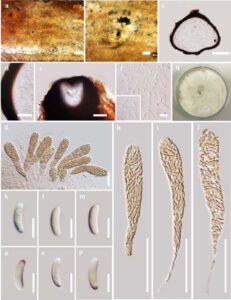Allocryptovalsa elaeidis Konta & K.D. Hyde, in Konta, Maharachchikumbura, Senanayake, McKenzie, Stadler, Boonmee, Phookamsak, Jayawardena, Senwanna, Hyde, Elgorban & Eungwanichayapant, Mycosphere 11(1): 246 (2020)
Index Fungorum number: IF 556570, Facesoffungi number: FoF05116
Etymology – Epithet refers to host genus, Elaeis
Holotype – MFLU 15-1438
Saprobic on dead petiole of Elaeis guineensis (Arecaceae). Sexual morph: Stromata (285–)330–730(–950) μm long, (250–)350–890(–1030) μm wide (x̄ = 568 × 600 μm, n = 20), mostly solitary, sometimes gregarious, surrounded by black circle on host surface, immersed to erumpent in the bark, black, raised, pustulate, dome-shaped, 1–2-ascomata, with umbilicate ostiole appearing on the surface of stroma. Ascomata (including neck) 325–460 μm high, 315–515 μm diam. (x̄ = 365 × 400 μm, n = 20), perithecial, immersed in the stroma, covered with the epidermis of plant tissue, delimited by a black zone in host tissues, globose to subglobose, glabrous, ostiole individual, with a short neck. Ostiolar canal 180–250 μm high, 160–230 μm diam. (x̄ = 250 × 230 μm, n = 5), sulcate, with periphyses. Peridium 25–86 μm wide (x̄ = 46 μm, n = 30), composed of two sections, outer layer dark brown, thick-walled cells, arranged in textura angularis, inner layer hyaline, thin-walled cells of textura angularis. Hamathecium composed of 3–13 μm wide (x̄ = 6 μm, n = 40), filiform, septate, hyaline, unbranched, paraphyses. Asci (including stalks) (55–)68–147(−157) × 14–26 μm (x̄ = 97 × 18 μm, n = 30), apex-bearing part (1.7–)2–4(−5.5) μm long (x̄ = 3 μm, n = 30), polysporous, unitunicate, clavate, with moderately short stalks, stalk-bearing part 35–56 μm long (x̄ = 50 μm, n = 10). Ascospores (6–)7.5–9(−10.5) × 2–4 μm (x̄ = 9 × 3 μm, n = 100), overlapping, yellowish to brown, ellipsoidal to cylindrical or elongate-allantoid, aseptate, smooth-walled. Asexual morph: Undetermined.
Geographical distribution – Thailand.
Culture characters – Ascospores germinated on Malt Extract Agar (MEA) within 24 hours. Colonies on MEA, dense but thinner towards the edge, margin diffuse, white of upper surface (Fig. 2q).
Additional sequence data – LSU (MN308401), SSU (MN308419) (MFLUCC 15-0707).
Material examined – THAILAND, Krabi Province, on dead petiole of Elaeis guineensis Jacq. (Arecaceae), 3 December 2014, S. Konta, KBM01f (MFLU 15-1438, holotype); ex-type living culture = MFLUCC 15-0707.
Notes – Allocryptovalsa elaeidis is morphologically most similar to A. polyspora, overlapping in the number of ascomata per stroma, size of ascomata and asci (Senwanna et al. 2017). Although A. elaeidis and A. polyspora are morphologically similar, the phylogenetic analyses strongly support these collections as two distinct species. Allocryptovalsa elaeidis differs from A. cryptovalsoidea, A. polyspora, and A. rabenhorstii in host association, that is Elaeis guineensis (A. elaeidis), Ficus carica (A. cryptovalsoidea), Hevea brasiliensis (A. polyspora), Robinia L. and Vitis vinifera (A. rabenhorstii), respectively (Saccardo 1882, Trouillas et al. 2011, Senwanna et al. 2017). The species of this genus have been reported from Australia, Germany, Thailand, and USA (Saccardo 1882, Trouillas et al. 2011, Senwanna et al. 2017). Thus, A. elaeidis is introduced as the fourth species in Allocryptovalsa based on its different morphology coupled with high support values from the phylogenetic analysis (100% ML, 1.00 BYPP).

Figure 1 – Allocryptovalsa elaeidis (MFLU 15-1438, holotype) a Stromata on host substrate. b Close up of stroma. c Section of ascoma. d Peridium. e Ostiolar canal. f Paraphyses. g–j Asci. k–p Ascospores. q Colony on MEA. Bars: a = 500 μm, b, c = 200 μm, d, e = 20 μm, f = 10 μm, g–j = 50 μm, k–p = 5 μm.
